Alice Frost may call herself an ordinary girl with an ordinary sewing machine, but we beg to differ. One look at her collaged and stitched pictures and you’ll see there’s something quite extraordinary about Alice’s free motion machine embroidery.
With just her sewing machine and scraps of fabric Alice creates expressionistic textile images inspired by nature. Look closely and you’ll see the fabric pieces, the textures and fine stitching. But step back and those elements unite to create scenes of landscapes, seascapes, trees, flowers, meadows and streams that are incredibly true to life.
As you notice Alice’s keen observation of light and shade, shape and perspective, you’ll gain a visceral experience of the natural beauty that animates this Danish textile artist.
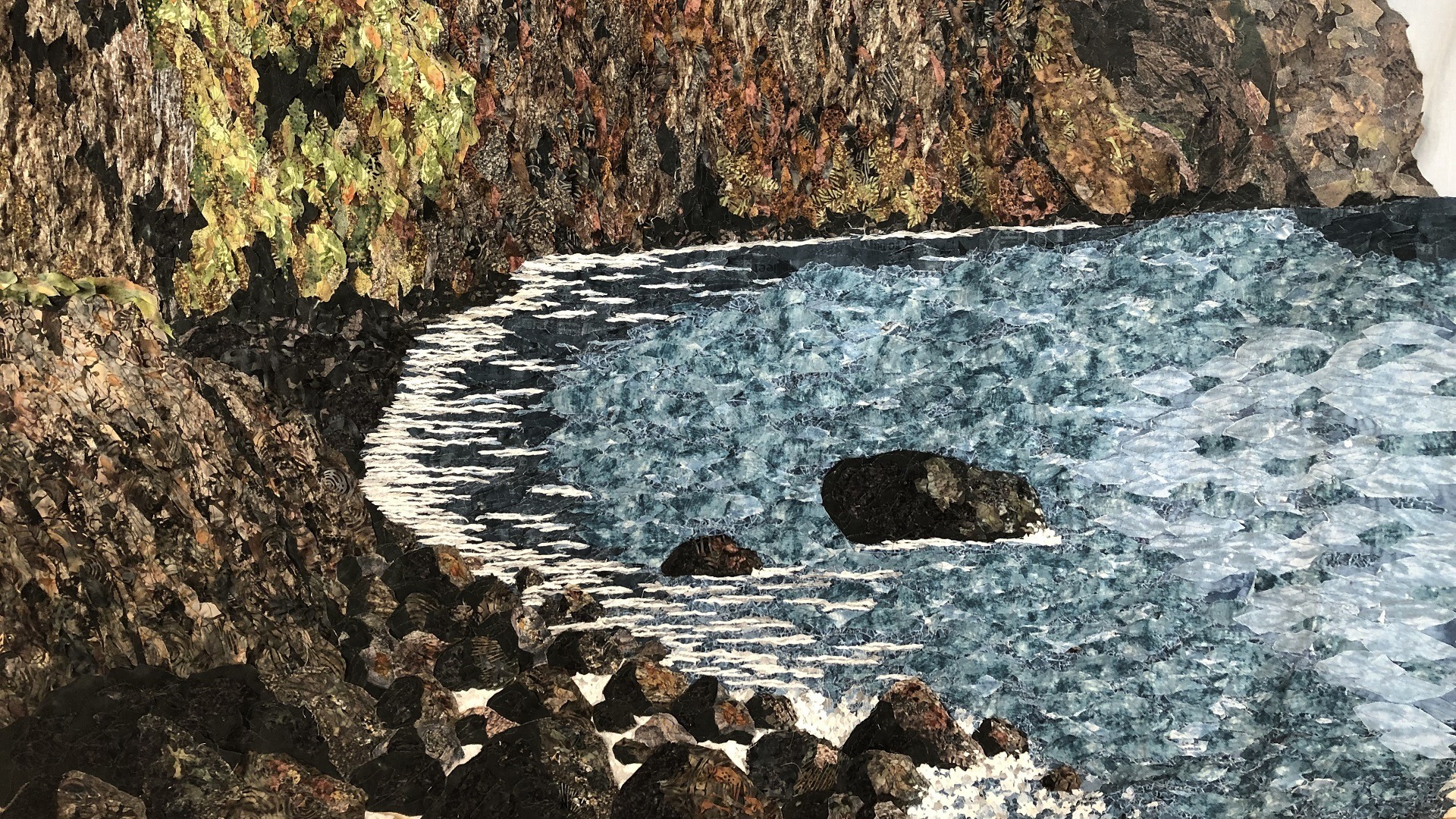
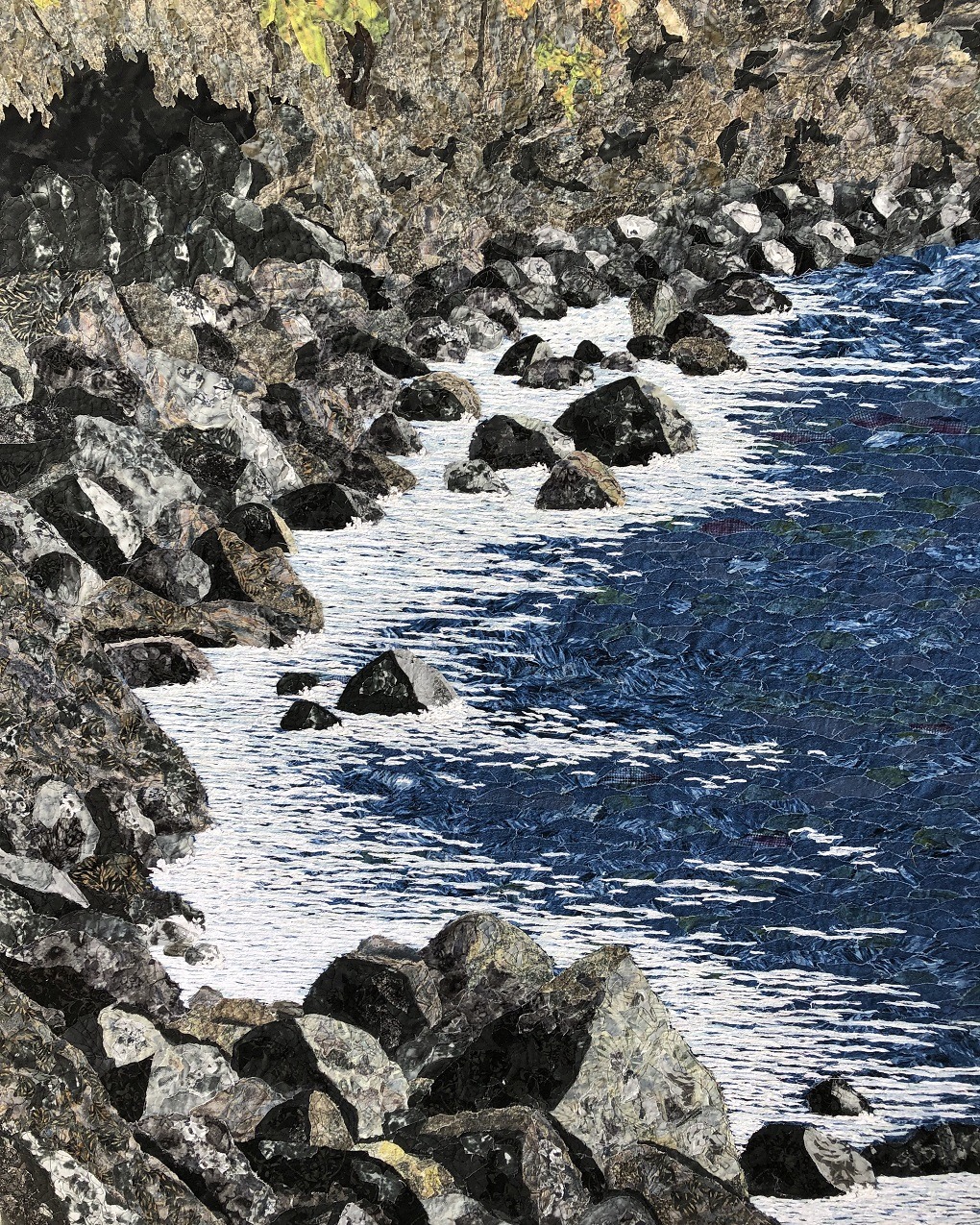
Nature as inspiration
Alice Frost: ‘Nature is the greatest source of inspiration for me. Lush and generous, it keeps on giving morning to evening, through changing weather and seasons. Whether you’re into colourful flowers, peaceful forests, majestic mountains, roaring waterfalls, the vigorous foliage of summer or the colourful intensity of autumn – the globe has it all.
‘Nothing in nature is perfect, as the individual elements blend to coexist alongside each other. The countless deviations within the whole create a fantastic scenario that I aim to translate with textile art.
‘What I see in nature has a deeper meaning and draws parallels to life as a human being. I often express life’s emotions and lessons through my textile art. At other times I simply wish to recreate what the eye sees. I think it is the diversity of beautiful patterns, colours and structures, and the many possibilities for use, that draws me to textiles.
‘The challenge for me is to create a photo-realistic image, using only textiles, with the limitations inherent in this medium.’
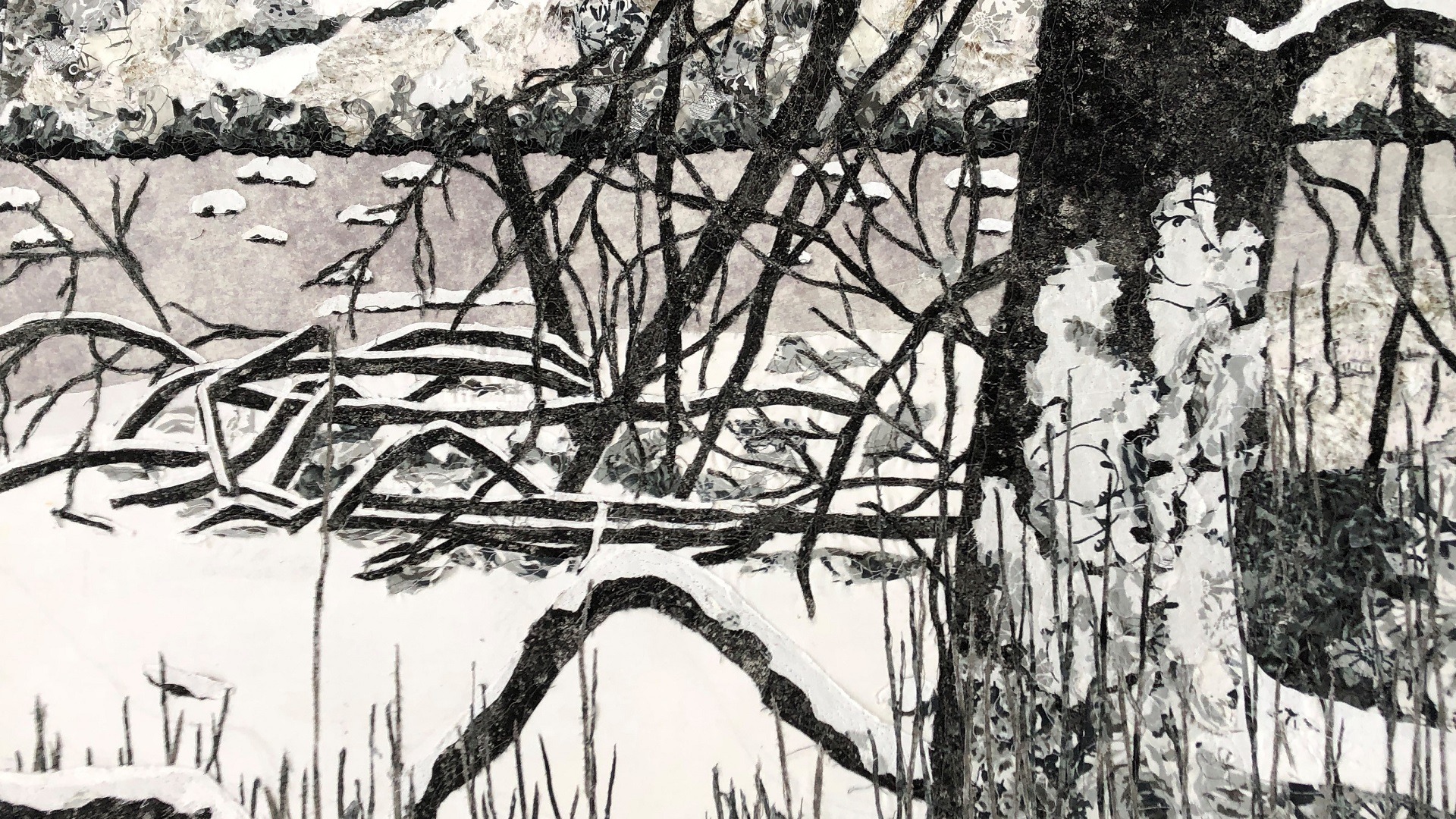
Discovering textiles
‘The creative universe has been an essential part of my life since I was very small. My grandmother was a skilled embroiderer who introduced me to the craft when I was five years old. My father sewed cross stitches while he sat on long night shifts and my mother was a keen and skilled knitter.
‘In second grade we learned to knit. With it came the understanding of right, wrong, insertion and removal – and the seed for something bigger was sown.
‘At the age of 12, the time had come to try my hand at bigger projects, and, under my mother’s careful watch, I recall making a blue sweater with a white pattern border and raglan sleeves on a circular needle. My interest in needle craft was well and truly kindled.
‘In my teenage years, my imagination knew no bounds. My patience was endless and I tried all kinds of creative challenges. I got to know the textile medium in all its guises, finding possibilities and limitations in both fabrics and yarns. I draw on these past experiences every single day to stimulate my imagination.
‘In 2003, I attended a six-hour course in stitching a picture and realised this was the answer to the challenges I’d so long sought. I never looked back.
‘Collaging and free motion embroidery called for creative thinking and technical skills. I had to use my imagination, take a stand and make decisions in each and every project. And I had to find the techniques that created the best expression for that particular image. I was sold.
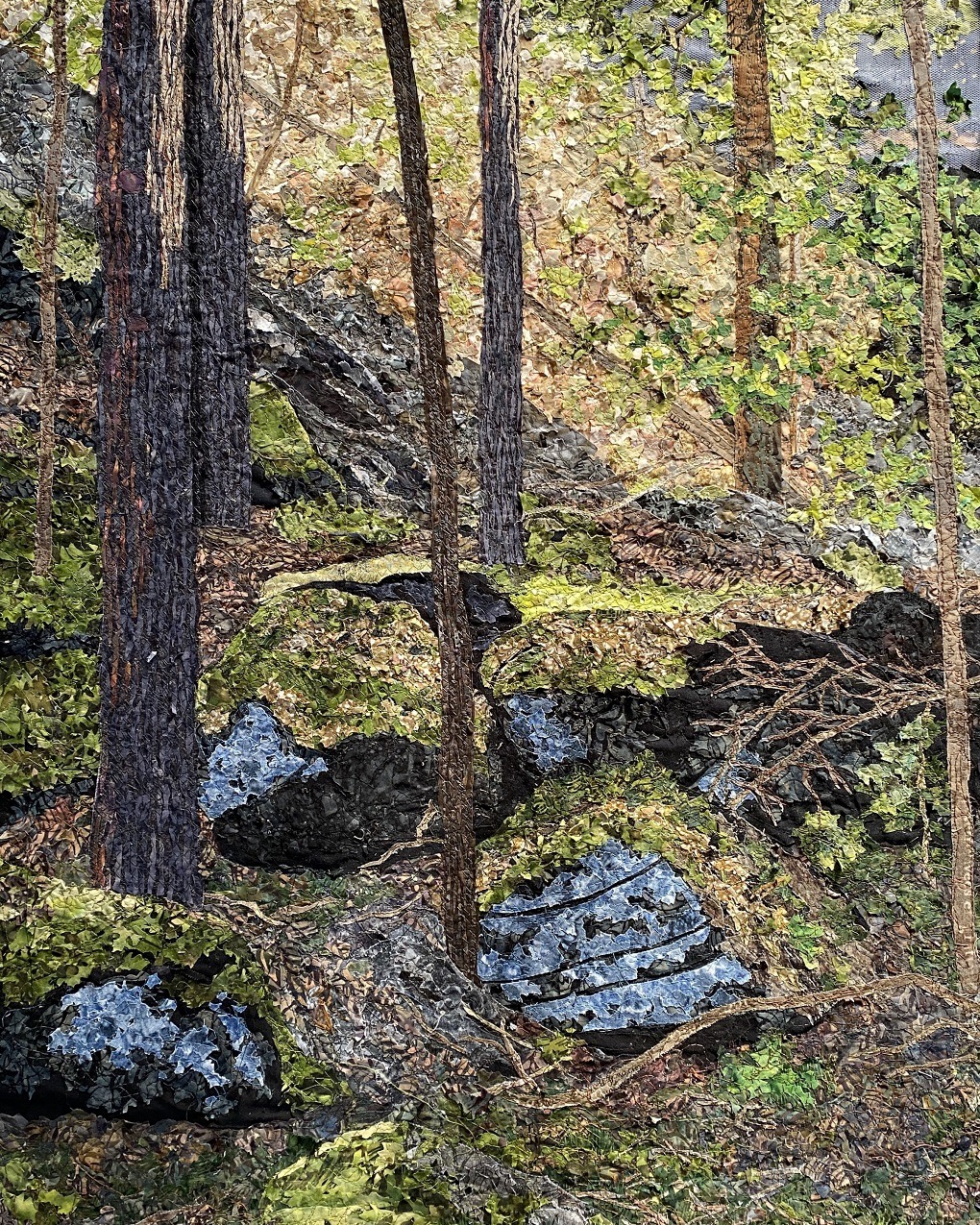
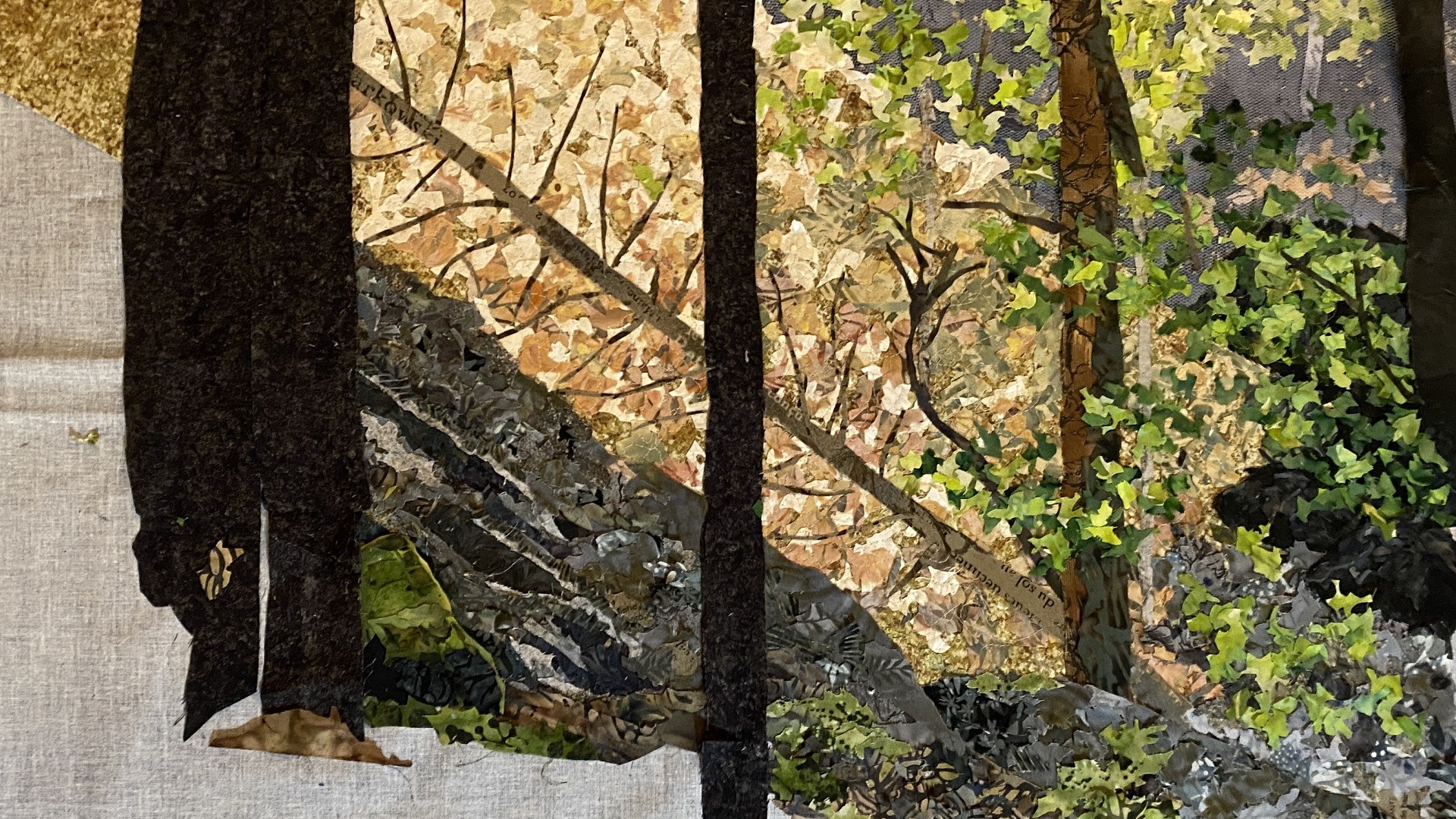
Courage and recognition
‘As the wider world became aware of my work, I was asked to stage an exhibition. I had always been content with making things for my own pleasure within the four walls of my home, so the idea of exhibiting was scary. I had absolutely no idea where to begin.
‘One year and 40 pictures later, I took a deep breath and approached Ragnhild Battefeld who ran a gallery called The Little Barn in Ejstrupholm, Denmark. Here in Denmark, there aren’t very many textile artists, so it’s a relatively unknown form of artistic expression. But Ragnhild believed in my abilities, taught me about exhibiting and encouraged me to hold courses.
‘Ragnhild initiated me into the exhibition world and in October 2006 I opened my first show – it was a fantastic and indescribable experience. Not in my wildest dreams or fantasies had I ever imagined that my creative side could forever change my world in this way.’
‘A world opened up to me that was completely foreign, that required a radical change in my self perception, and that required all the courage I could muster. From an anonymous everyday existence with a job and a family, I was transported to a life of exhibitions, courses, lectures and a public profile.
‘Embracing this new world has been mind-blowing for my self-development, and I’ll be forever grateful for the unwavering support from my husband and then two teenage children. They gave me strength and courage, with their unfailing interest and faith in my abilities. They travelled with me around the country to exhibitions and fairs, and when new challenges came, where I had difficulty believing in myself, their faith, optimism and loving pressure were enough for me to throw myself into the challenge and solve any problems.
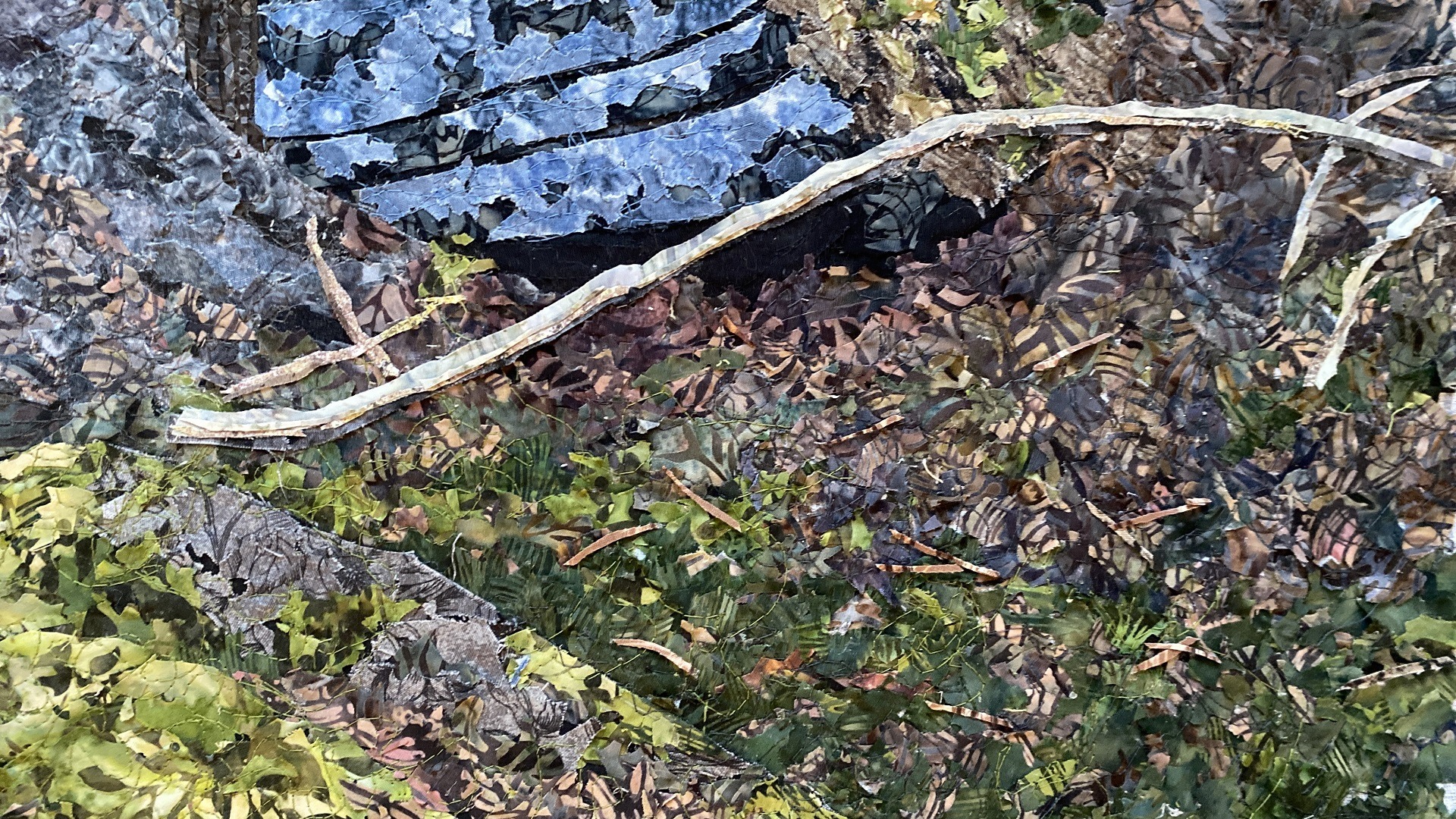
Creative process
‘Because I’m self taught, with no handicraft or art education behind me, I’m not bound by rules and learning, but solely follow my intuition. I’ve always had a great need to test myself. Those challenges fascinate me, and every single day provides me with a source of joy, well being and self development.
‘My works are never planned in detail. I have an overall idea, but where it will end I never know. I find the possibilities, new paths and solutions along the way. I have to decide on technique, composition, structure, colours and fabrics, which means I have to make many choices and experiment.
‘I work from a small study in our home where I store all my materials and around 400 creative books. But I rarely use the workroom when I produce my works: I feel at my best sitting on the floor with fabrics spread all around me.
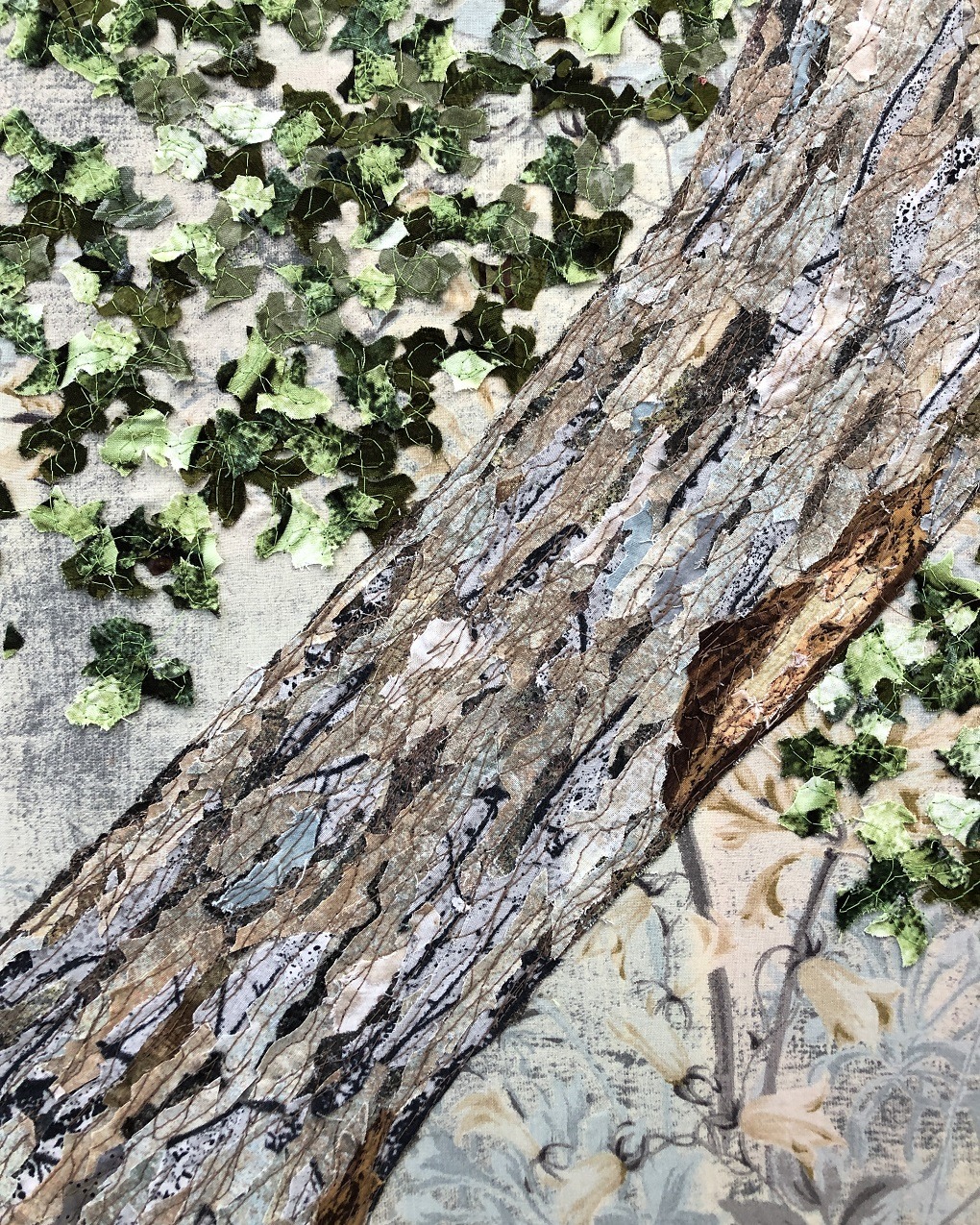
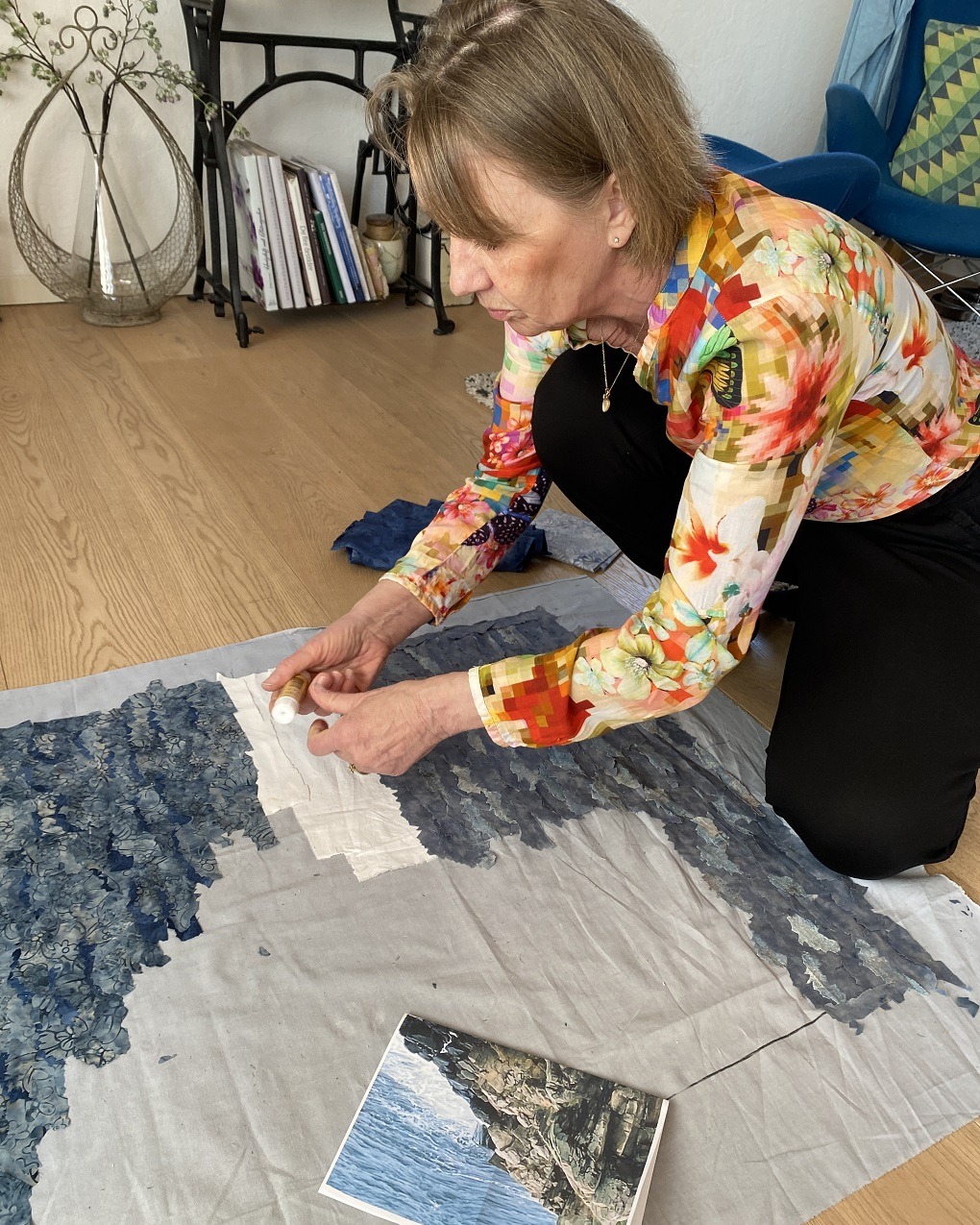
‘I don’t use a sketchbook, but take a lot of photos when I’m out and about in nature. Many of these photos never get used, but I instinctively know when one meets all the requirements for interest, composition and perspective. Otherwise, I simply use my imagination.
‘I always use cotton fabrics. They are comfortable to work with and available in a myriad of colours and patterns. Whether I buy them in a patchwork shop or find a tablecloth or a duvet cover in the local thrift shop, is irrelevant to the final outcome.
‘One thing I’ve learned is that patterned fabrics work best. Since cotton fabric is not transparent, it is easier to get patterns to meld together and create a whole. So I rarely use solid coloured fabrics. I’m open to all kinds of patterns, as their combinations can sometimes surprise me. Sometimes I use a little tulle, as it’s transparent and can dissolve sharp lines, illustrate fog and shadows, and create distance.
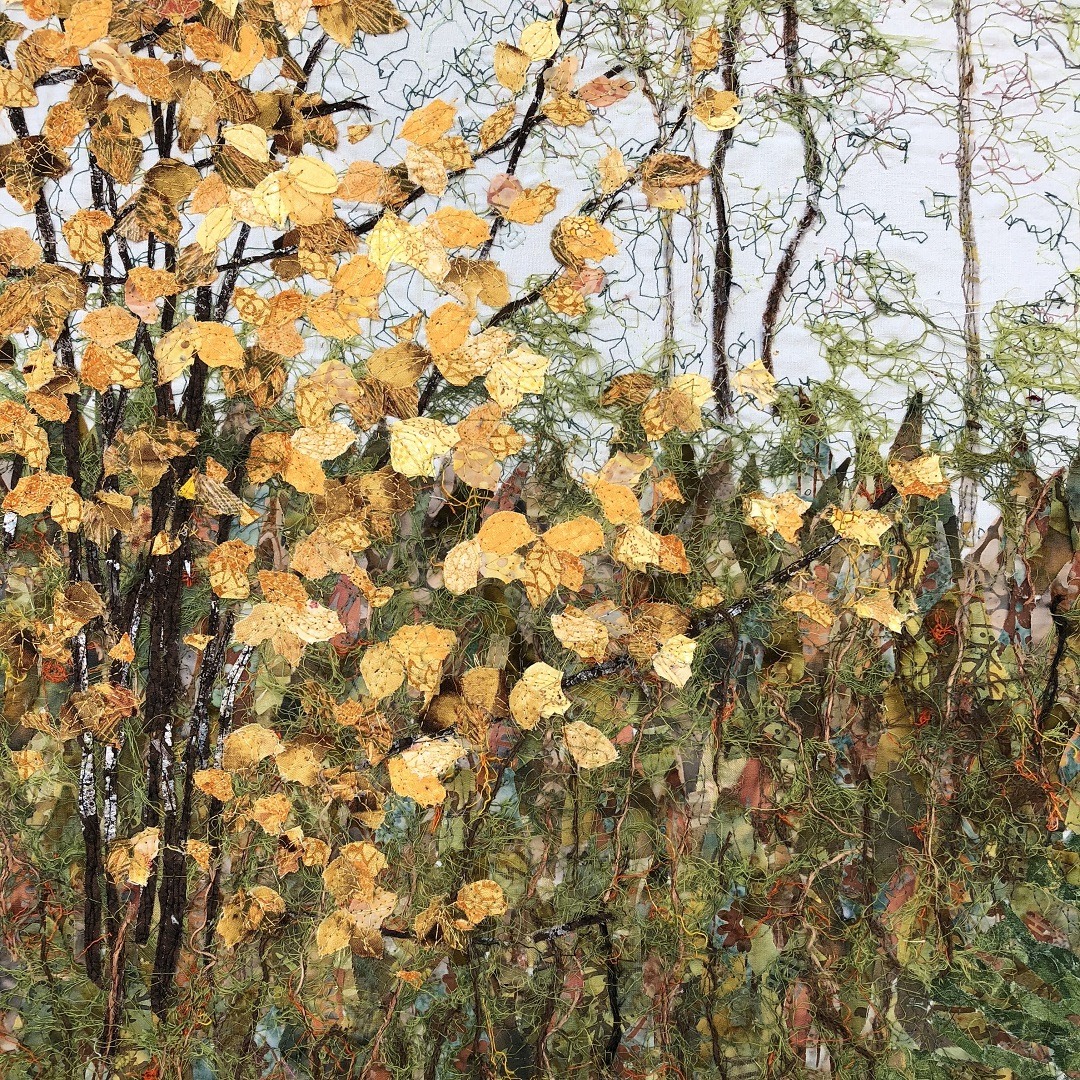
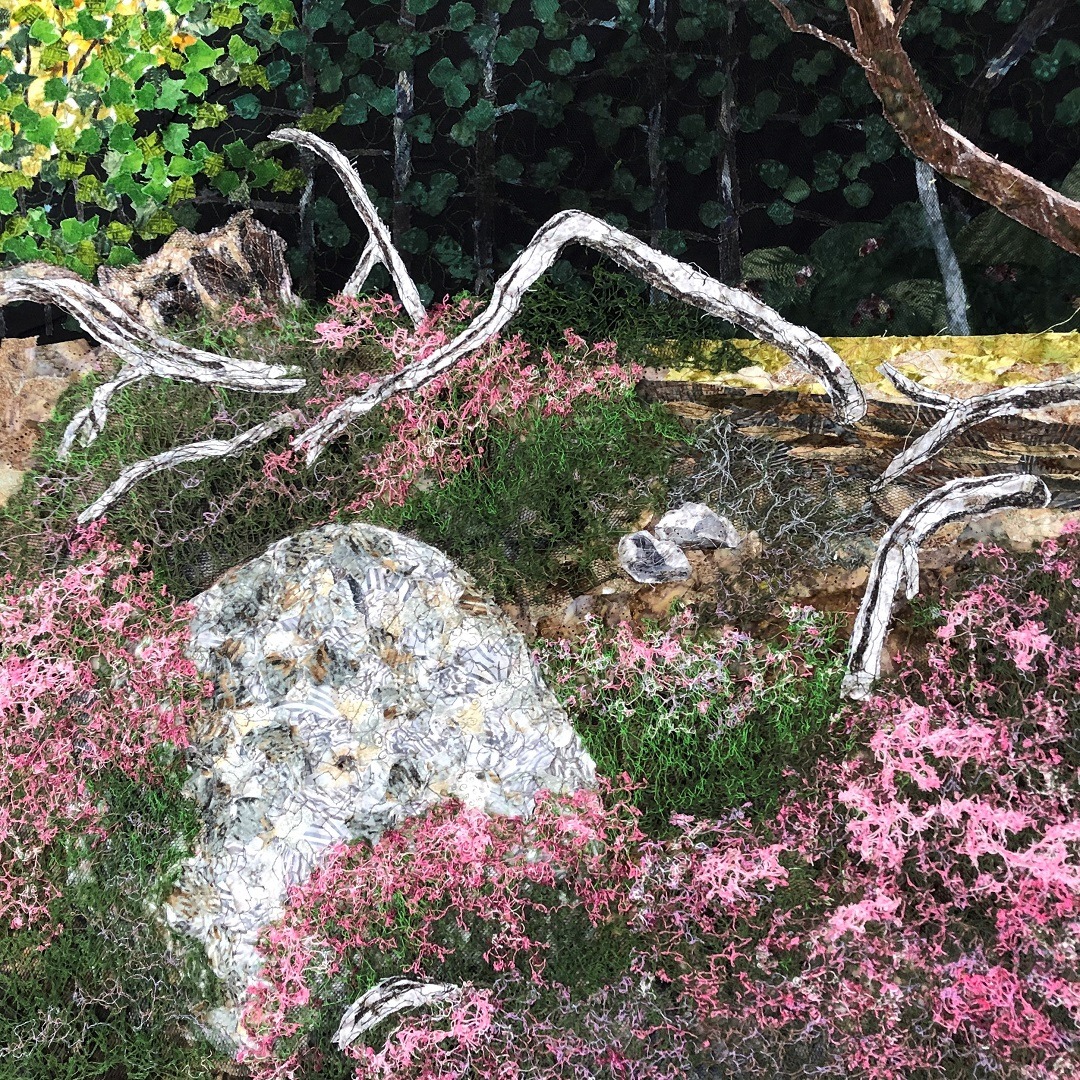
‘Sometimes I stitch the shapes and colours I want onto water-soluble embroidery fabric. I use Sulky Ultra Solvy Soluble Stabiliser. These elements add an exciting structure to the picture and then the colour of the thread really matters. But otherwise, I use any thread that blends in with the fabric.
‘The only immediate decision I make is the size of the project. My canvas is a piece of plain cotton on which I outline the size of the image and nothing else. Some people work best with patterns that they have created via Photoshop or make drawings on the fabric, but I do neither.
‘I start furthest back in the horizon, work my way forward in the image, and build it up layer upon layer using collage.
‘I cut countless pieces of fabric in different sizes, colours, patterns and shapes. It can be like small confetti or much larger elements. I attach the small pieces of fabric to my canvas with glue sticks and they are all left with raw edges. I continuously sew the elements using free machine embroidery.
‘Many times in the process I view the image from a distance to assess whether it meets the composition and perspective, whether the colours work or other changes need to be made.
‘Sometimes I ‘meet the grumbler’ and can’t see how to move forward. Then I put the project away for a while until one day it resurfaces. I look at it with fresh eyes, and usually the solution becomes obvious.’
‘When the picture is finished, I iron it and glue it onto a real canvas, fold the edges over on the back and secure it with a staple gun.
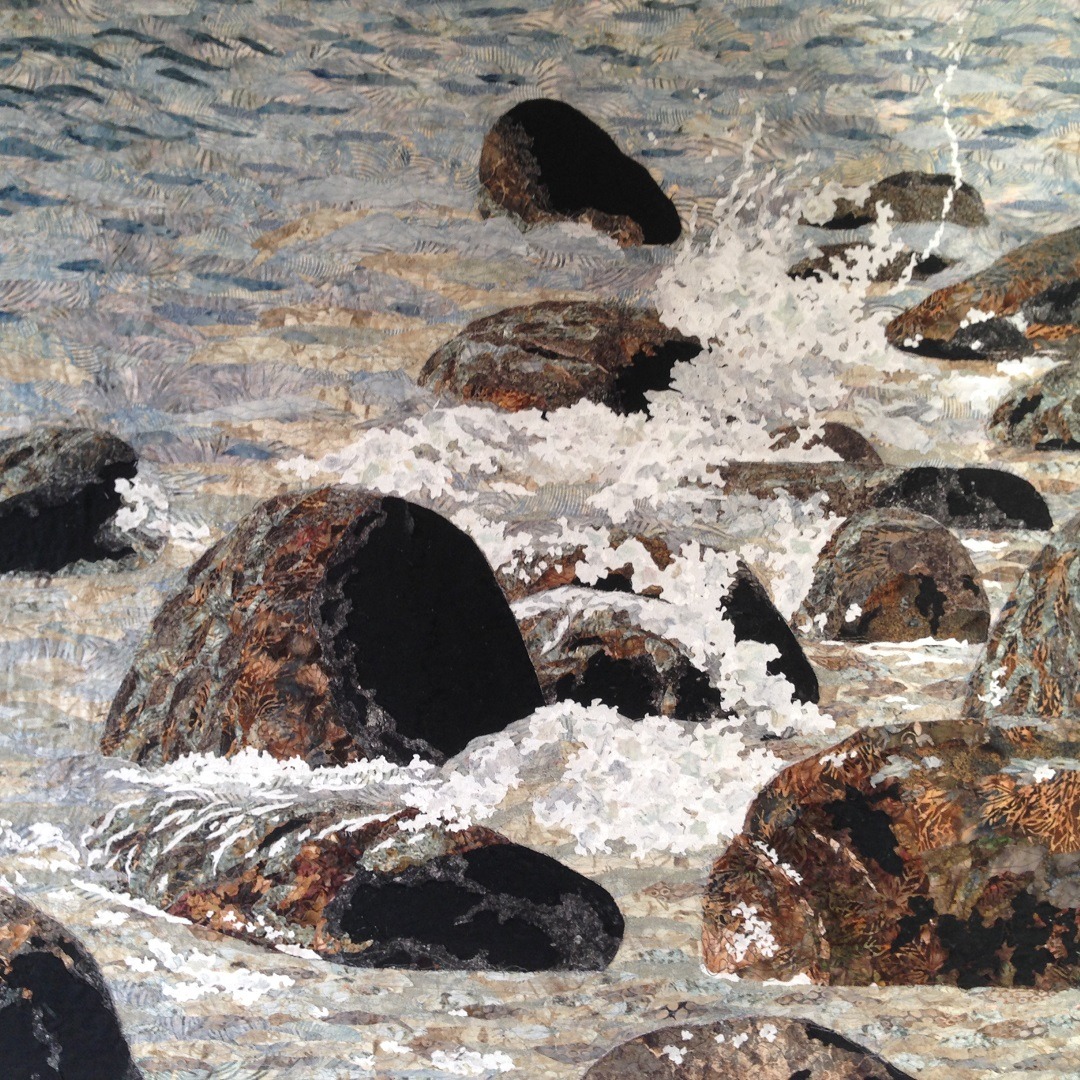
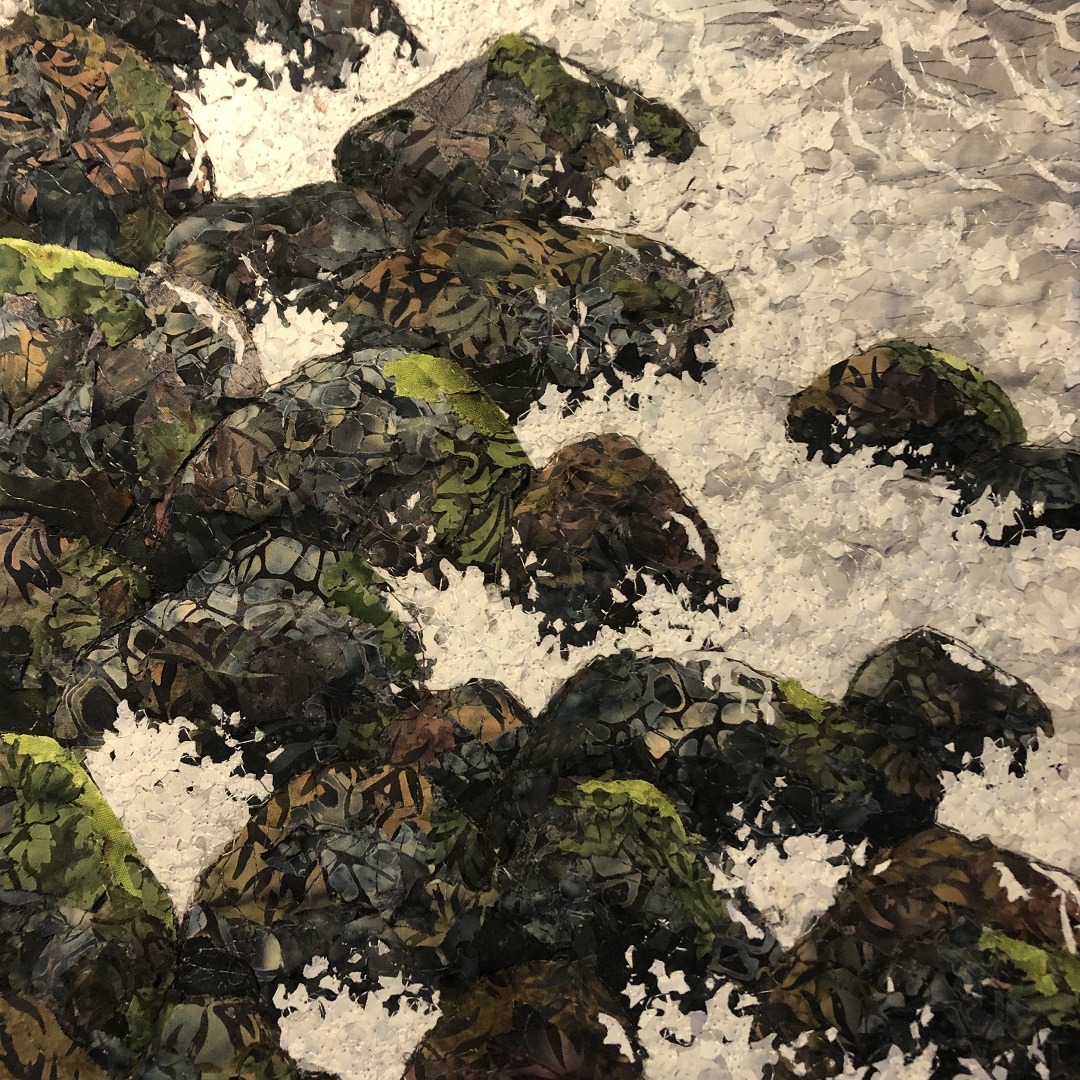
Expressing vulnerability
‘One of my artworks closest to my heart is Vulnerable But Strong. In 2013, Denmark held an exhibition at the Carrefour Européen du Patchwork, Alsace. Fifty Danish quilters were invited to contribute. Although I’m a former quilter, I wanted the project to reflect that I’d started making textile images. So the top is made with my usual technique: cut, paste, stitch, layer upon layer.
‘Since it’s a large project and was supposed to be a quilt 120cm x 180cm (47″ x 71″), I decided it was too big to make using free machine embroidery. So I chose to divide it into four sections to make it more manageable: three squares and a frame. I later assembled the individual modules in three layers and machine quilted them separately.
‘I chose to make the sections in different colour strengths: light, medium light, medium dark and completely dark so it appeared like a colour wash. I was going to assemble them in the normal way but had the idea of sewing them together with beads. The edge is also stitched on with pearls in a grey-brown colour.
‘I chose the poppy motif because it’s a flower that fascinates me. It has enormous strength and can grow in the most barren of places, yet also contains enormous vulnerability and dies the moment it’s picked. And it’s beautiful in its simplicity.
‘I had some challenges growing up that at times left me feeling vulnerable. But my inner mental strength enabled me to create a good life, and the challenges have given me a unique insight into life and my understanding of people. I sewed this quilt during one of my vulnerable periods, and in the process recognised the symbolism for my own life.
‘If you look closely on the left, you can see the woman whose legs disappear into the poppy field. It symbolises my confidence in always regaining my balance after a vulnerable period. The pearls are an illustration of poppy seeds, but also of everything I had to learn and understand about my challenges so that I could handle and accept my scars on the soul.
‘This quilt always gets a lot of attention and could have been sold many times over. But it has great personal value to me, and so I still have it.
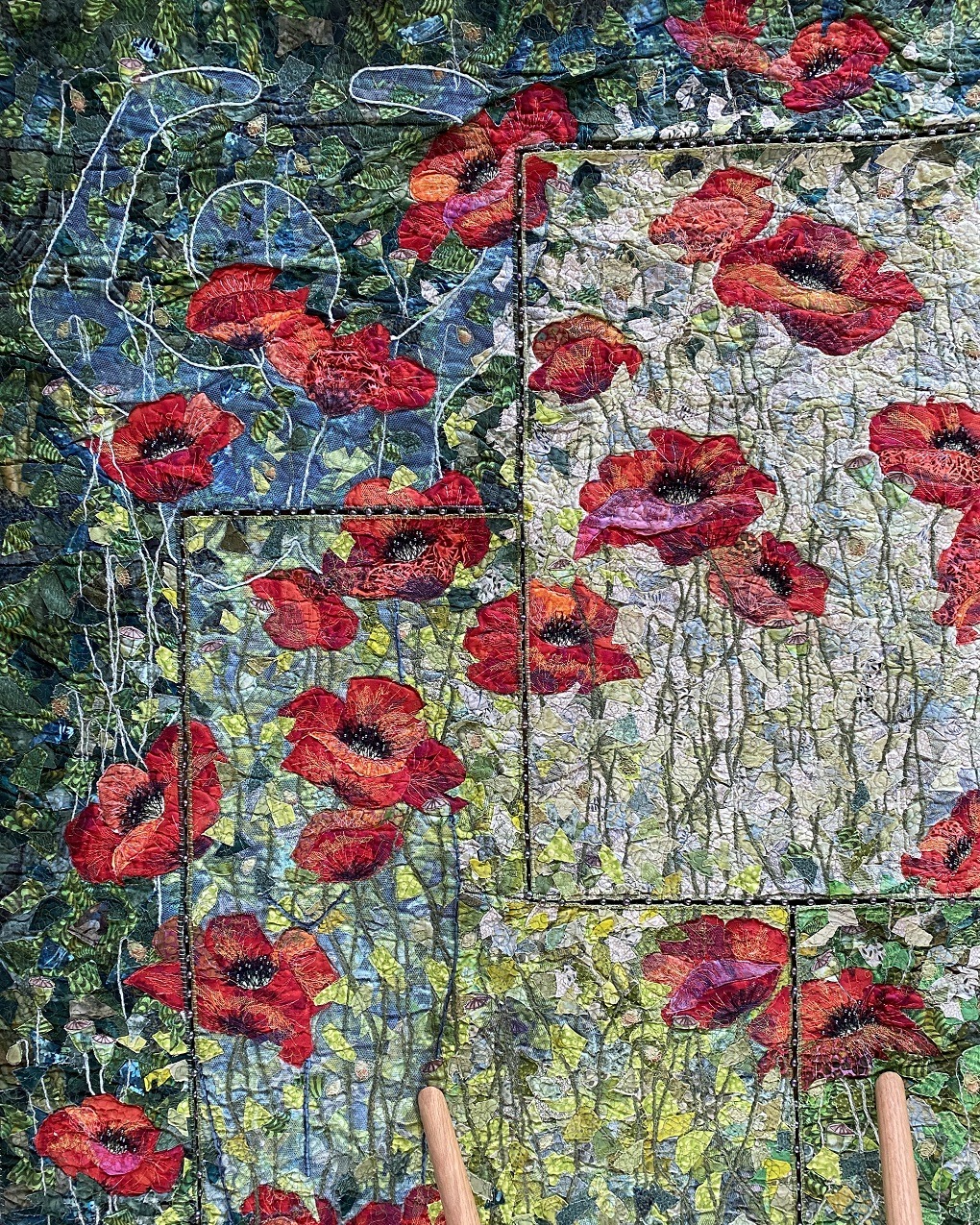
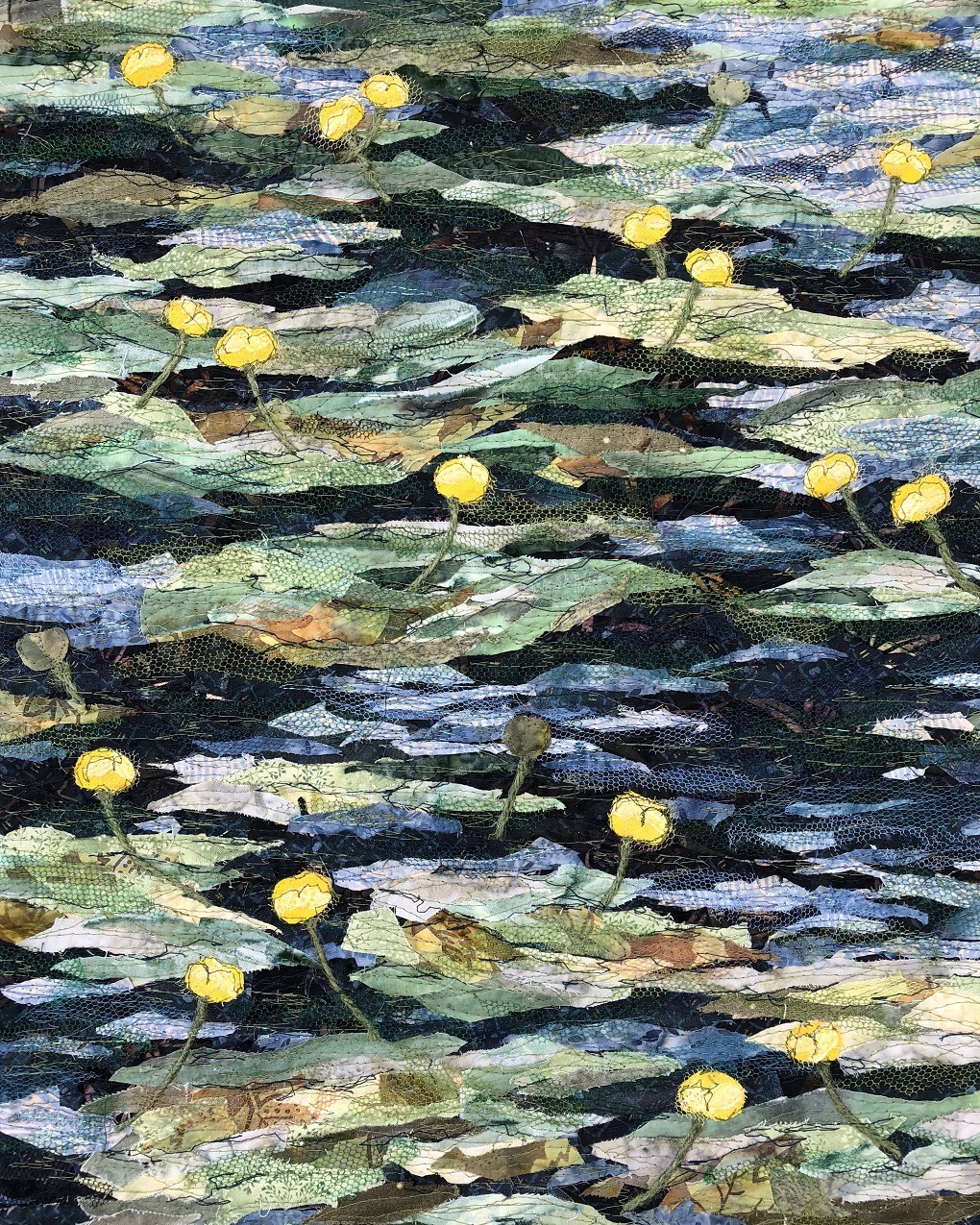
Overcoming challenges
‘The biggest practical challenge for me has been finding how to cut the individual elements so that they contribute in the best way to the overall expression. I’ve tried making them big, and small, with straight edges, uneven edges, round shapes and random shapes. I’ve come to the conclusion that random shapes with uneven edges fuse the best.
‘My biggest personal challenge is still accepting that not everything will be a masterpiece. That some images turn out to be of low quality, that I sometimes still make mistakes despite all my experience.’
‘I am a private person and that can be testing. I have no problem lecturing to a hundred people or holding courses. But sometimes, being recognised in public has been a challenge for me. I only recently gave up my part-time job at a local children’s dental clinic and I’ve never been a full time artist. But others can put you on a pedestal: they don’t see all the trials, thoughts and frustrations that can lie behind the great work. I still see myself as an ordinary girl with an ordinary sewing machine.
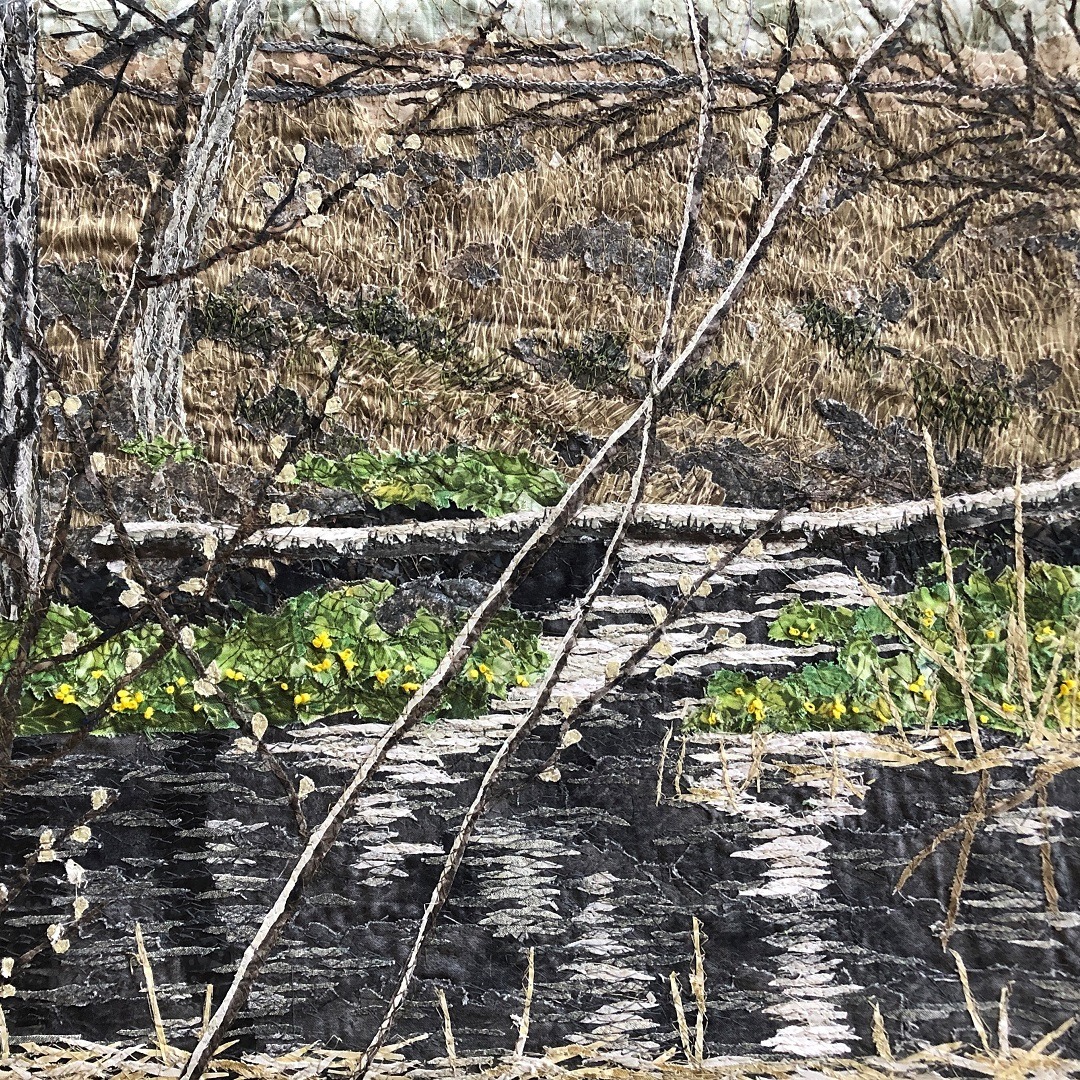
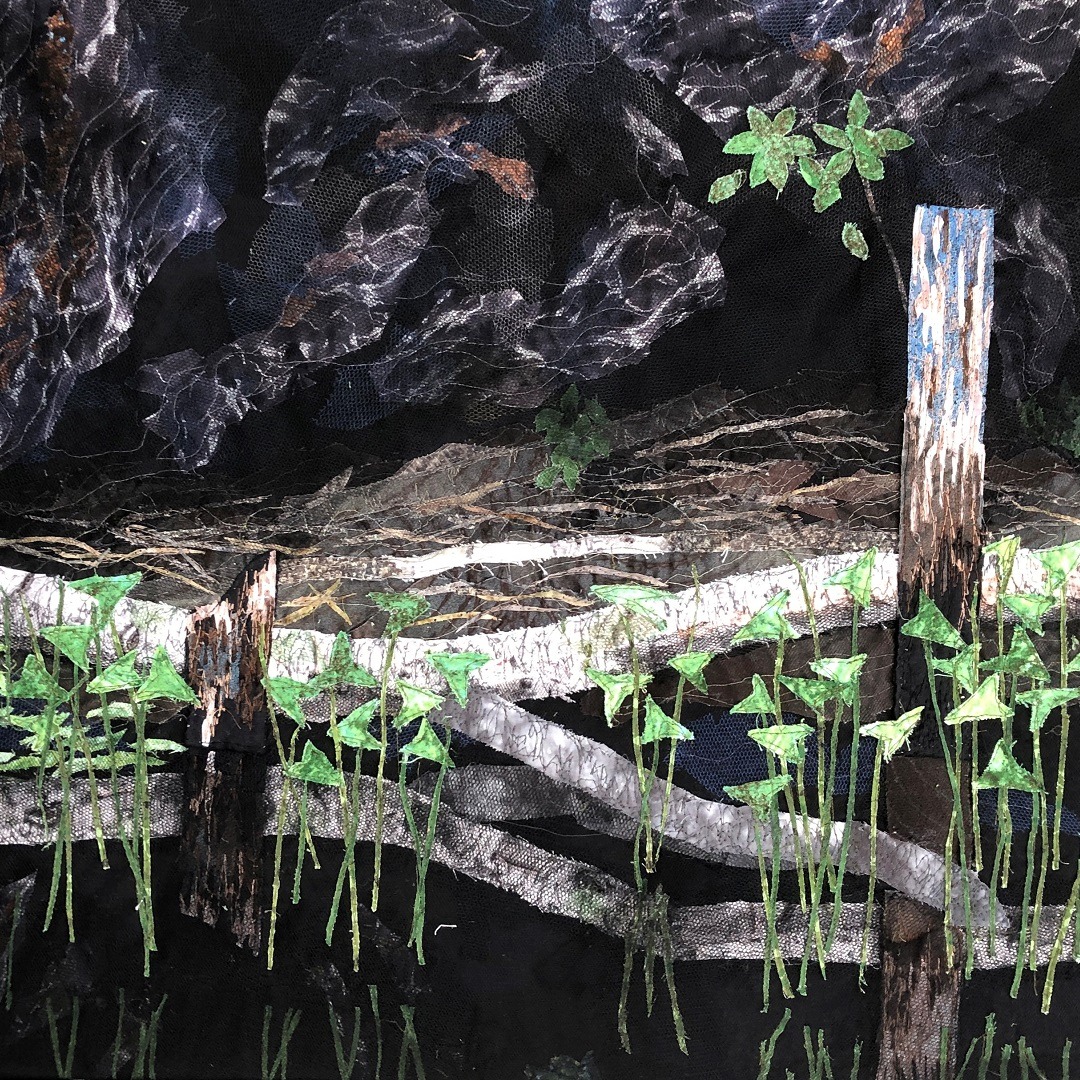
Alice’s advice
‘My advice to budding textile artists is to be patient, indulge yourself, and allow yourself to fail.
‘Becoming good at something requires practice and experience, but also that you’re curious and open to developing yourself. A good deal of stubbornness is also an important factor! Then seize the opportunities as they present themselves.
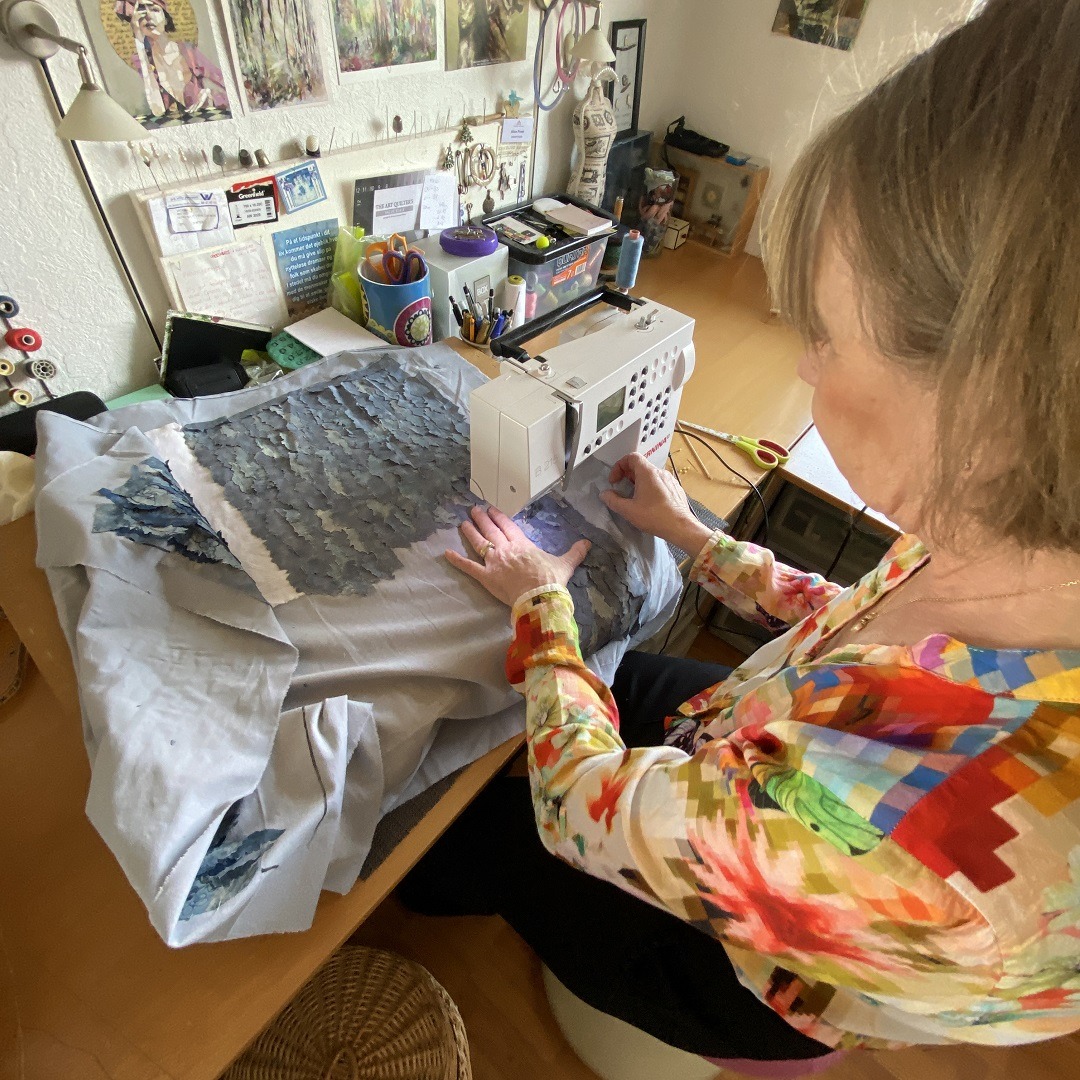
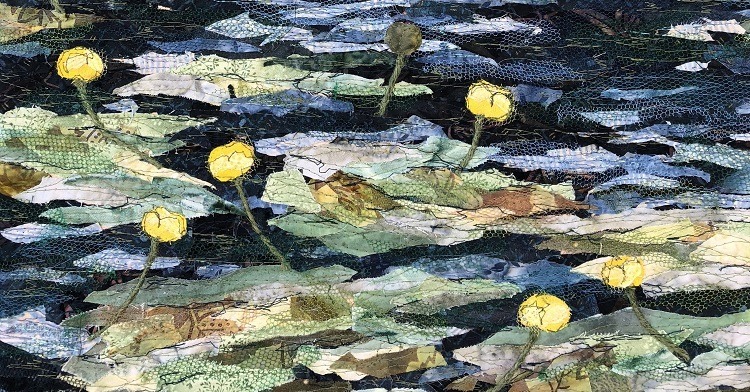

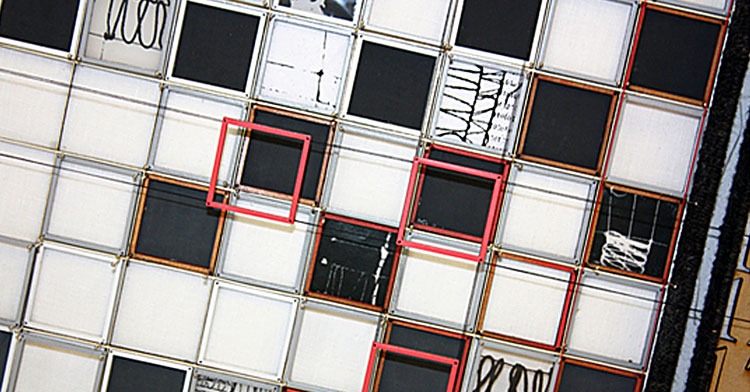
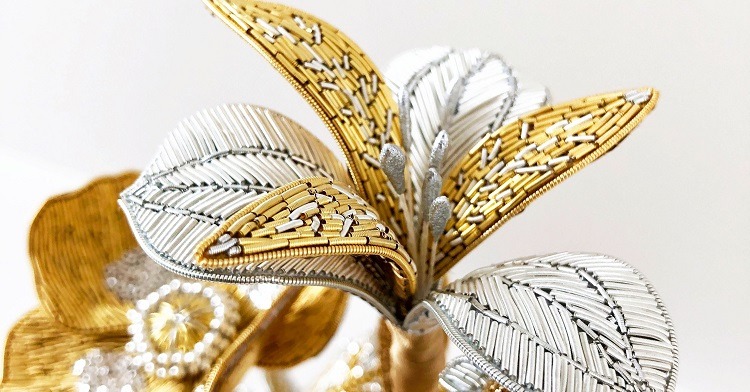
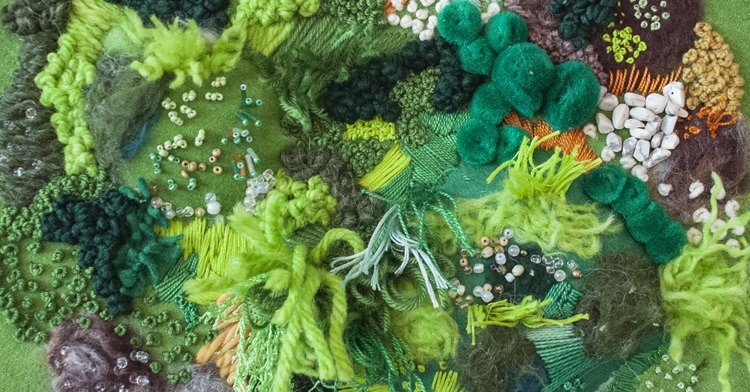
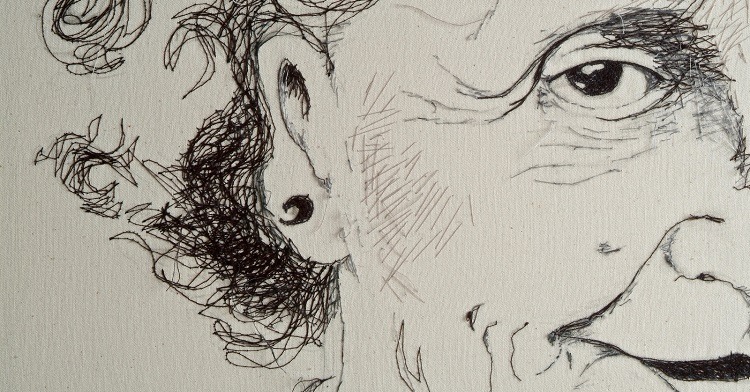
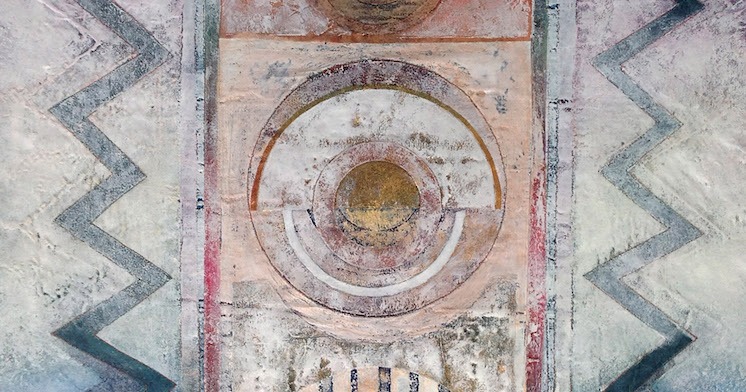
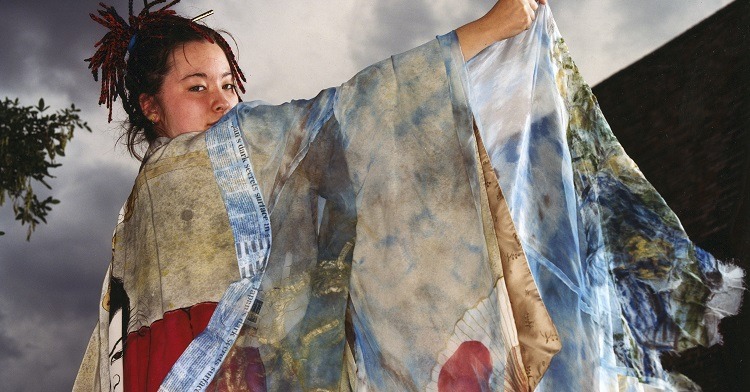
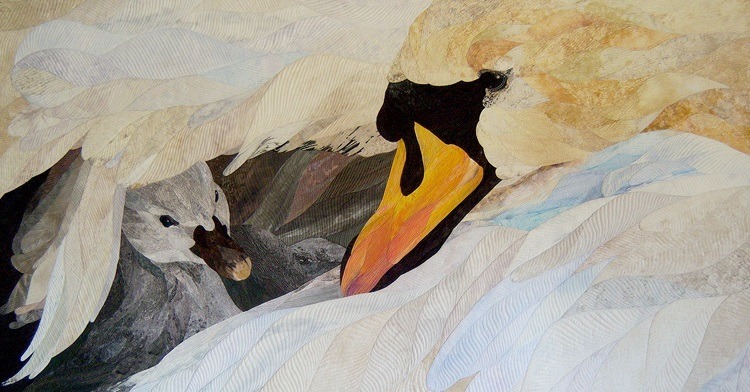
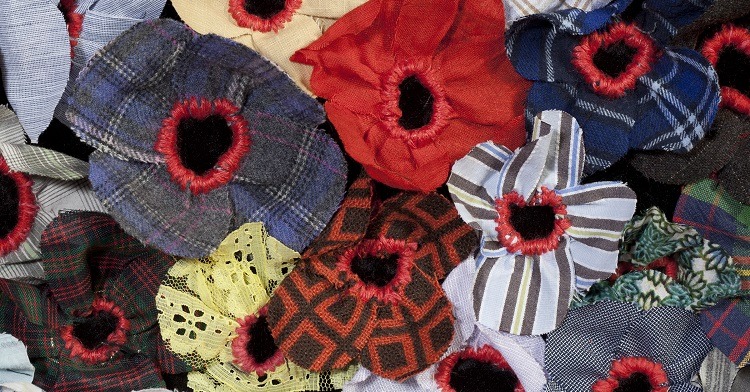
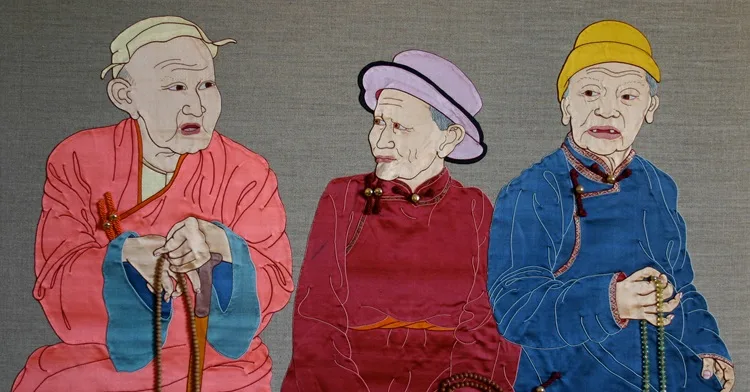
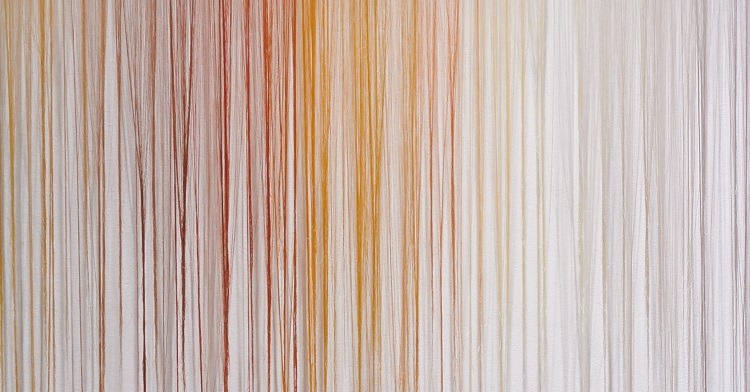
13 comments
Beth
Your sense of color, depth and layout are inspiring and a visual delight. I keep returning to your work to admire and marvel.
Jan hine
Thank you. It is great to hear somebody say that they do not draw but create from within and takes photos to capture a memory or image. I love your art work. Great depth of field. I am super impressed.
Perhotelan
an objective
Emma Jones
Thank you so much for sharing your wonderful work. I’m so glad I got this article in my inbox. Your emotion and passion shines through in your pieces and has reminded me of my lost passion and has sparked something in me to try after so many years to rekindle my love for textile art, no matter the outcome. Such an inspiration, thank you.
Rosângela
Maravilhoso. Vocês sempre publicam artistas maravilhosos. Sou encantada contudo que se refere a linhas agulhas e tecidos. Parabéns artista sensacional Alice Frost. Sou do Brasil. Moro em Pindamonhangaba ,estado de São Paulo.
Linda C Greiss
Fabulous artist & article! Thank you!
Alice Frost
Thank you for all the nice words. I am honered to be able to be an inspiration to others. Sirencely Alice
Vicky Godel
Great article, such a wonderful interesting artist! Thanks so much!
Sylvia Fielding
Thank you so very much for featuring Alice Frost’s work, which is fabulous. I’ve dabbled with fabric collages in the past and loved it, but recently I’ve veered into all sorts of different craft projects which has left me in a complete muddle and overwhelmed. This article has made me realise that fabric collages are really my favourite thing to do and Alice has inspired me immensely by sharing her work and process. Thank you Alice, Joe and Sam.
Jo Collins
What a fab article, with lots of inspiration to take away and think about. Thank you so much. Jo
Rosemary
Thanks for sharing your beautiful work. This has inspired me to try collarge again.
Margaret Marks
This has inspired me to return to doing fabric collage which I have done in the past.
Thanks Alice for the inspiration.
Marjorie Lasebikan
Beautiful work. So realistic. It’s given me ideas for my art work too. Thanks for showing us. X